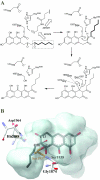New insights into the formation of fungal aromatic polyketides
- PMID: 21079635
- PMCID: PMC3181163
- DOI: 10.1038/nrmicro2465
New insights into the formation of fungal aromatic polyketides
Abstract
Fungal aromatic polyketides constitute a large family of bioactive natural products and are synthesized by the non-reducing group of iterative polyketide synthases (PKSs). Their diverse structures arise from selective enzymatic modifications of reactive, enzyme-bound poly-β-keto intermediates. How iterative PKSs control starter unit selection, polyketide chain initiation and elongation, intermediate folding and cyclization, selective redox or modification reactions during assembly, and product release are central mechanistic questions underlying iterative catalysis. This Review highlights recent insights into these questions, with a particular focus on the biosynthetic programming of fungal aromatic polyketides, and draws comparisons with the allied biosynthetic processes in bacteria.
Figures





References
-
- Keller NP, Turner G, Bennett JW. Fungal secondary metabolism - from biochemistry to genomics. Nat Rev Microbiol. 2005;3:937–47. - PubMed
-
- Hoffmeister D, Keller NP. Natural products of filamentous fungi: enzymes, genes, and their regulation. Nat Prod Rep. 2007;24:393–416. - PubMed
-
- Schumann J, Hertweck C. Advances in cloning, functional analysis and heterologous expression of fungal polyketide synthase genes. J Biotechnol. 2006 - PubMed
-
- Scherlach K, Hertweck C. Triggering cryptic natural product biosynthesis in microorganisms. Org Biomol Chem. 2009;7:1753–60. - PubMed
Publication types
MeSH terms
Substances
Grants and funding
LinkOut - more resources
Full Text Sources
Other Literature Sources
Medical
Molecular Biology Databases

